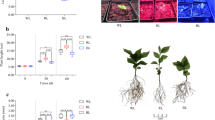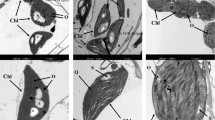Abstract
An artificial light source is the optimal element for studying the usability of the medicinal plant Astragalus membranaceus as a sprout vegetable. Based on artificial light source conditions, formononetin (FO) level was the highest (2.6 mg/L) in A. membranaceus exposed to white light emitting diode (LED) light, and calycosin (CA) level was the highest (3.09 mg/L) in the plant exposed to red LED light. According to the publicly available transcriptome data of LED-exposed sprout A. membranaceus LED, reference genes related to the content enhancement of FO, an isoflavone compound, and those related to the content enhancement of CA were selected. The expression patterns of these genes were assayed using qPCR. Among the genes related to FO enhancement, Gene-225190T showed the highest mRNA levels in cells of LED-white light-exposed sprout A. membranaceus; among the genes related to CA enhancement, Gene_042770T showed the highest expression under red LED light. Most genes related to the overall biosynthesis regulation of flavonoids of the upper concept of isoflavone were highly expressed in response to red LED light, and the transcriptional level of 4CL in response to red LED light was the highest. Based on these results, the artificial light sources that regulated the FO and CA contents in sprouts A. membranaceus were white and red LED lights, and the selected reference genes were capable of regulating isoflavone biosynthesis.





Similar content being viewed by others
Data availability
All data used in this research are included in this published article.
References
Chuang CW, Wen CH, Wu TJ, Li CC, Chiang NT, Ma LT, Ho CL, Tung GS, Tien CC, Lee YR, Chu F-H (2021) Sesquiterpene synthases of Zanthoxylum ailanthoides: sources of unique aromas of a folklore plant in Taiwan. J Agric Food Chem 69:12494–12504
Dong TTX, Ma XQ, Clarke C, Song ZH, Ji ZN, Lo CK, Tsim KWK (2003) Phylogeny of Astragalus in China: molecular evidence from the DNA sequences of 5S rRNA spacer, ITS, and 18S rRNA. J Agri Food Chem 51:6709–6714
Du H, Huang Y, Tang Y (2010) Genetic and metabolic engineering of isoflavonoid biosynthesis. Appl Microbiol Biotechnol 86:1293–1312
Feng X, Zhang Y, Wang H, Tian Z, Xin S, Zhu P (2020) The dihydroflavonol 4-reductase BoDFR1 drives anthocyanin accumulation in pink-leaved ornamental kale. Theor Appl Genet 134:159–169
Gai QY, Jiao J, Luo M, Wang W, Gua CB, Fua YJ, Ma W (2016) Tremendous enhancements of isoflavonoid biosynthesis, associated gene expression and antioxidant capacity in Astragalus membranaceus hairy root cultures elicited by methyl jasmonate. Pro Biochem 51:642–649
Gai QY, Jiao J, Wang X, Liu J, Wang ZY, Fu YJ (2019) Chitosan promoting formononetin and calycosin accumulation in Astragalus membranaceus hairy root cultures via mitogen-activated protein kinase signaling cascades. Sci Rep 9:10367
Gam DT, Khoi PH, Ngoc PB, Linh LK, Hung NK, Anh PTL, Thu NT, Hien NTT, Khanh TD, Ha CH (2020) LED lights promote growth and flavonoid accumulation of Anoectochilus roxburghii and are linked to the enhanced expression of several related genes. Plants 9:1344
Gill SS, Tuteja N (2010) Reactive oxygen species and antioxidant machinery in abiotic stress tolerance in crop plants. Plant Physiol Biochem 48:909–930
Goto E (2012) Plant production in a closed plant factory with artificial lighting. In: Proceedings of the Seventh International Symposium on Light in Horticultural Systems. Wageningen, The Netherlands, pp 14–18
Jiao J, Gai QY, Niu LL, Wang XQ, Guo N, Zang YP, Fu YJ (2017) Enhanced production of two bioactive isoflavone aglycones in Astragalus membranaceus hairy root cultures by combining deglycosylation and elicitation of immobilized edible Aspergillus niger. J Agricul Food Chem 65:9078–9086
Jiao J, Gai QY, Wang W, Luo M, Gu CB, Fu YJ, Ma W (2015) Ultraviolet radiation-elicited enhancement of isoflavonoid accumulation, biosynthetic gene expression, and antioxidant activity in Astragalus membranaceus hairy root cultures. J Agric Food Chem 63:8216–8224
Kamalipourazad M, Sharifi M, Maivan HZ, Behmanesh M, Chashmi NA (2016) Induction of aromatic amino acids and phenylpropanoid compounds in Scrophularia striata Boiss. cell culture in response to chitosan-induced oxidative stress. Plant Physiol Biochem 107:374–384
Kim JH, Park SY, Lim HK, Park AY, Kim JS, Kang SS, Youm JR, Han SB (2007) Quantitative evaluation of Astragali radix through the simultaneous determination of bioactive isoflavonoids and saponins by HPLC/UV and LCESI-MS/MS. Bull Kor Chem Soc 28:1187–1194
Kim JS, Kim YT, Kim CS (2002) A study on the constituents from the roots of Astragalus membranaceus Bunge (III). Kor J Pharm 31:109–111
Kohda J, Sasaki R, Suzuki R, Kugimiya A, Nakano Y, Takano Y (2022) Effects of light-emitting diode irradiation pattern on the anthocyanin content of Broccoli sprouts in a plant factory for the production of functional foods. Japan J Food Engineer 23:71–83
Kopsell DA, Sams CE, Barickman TC, Morrow RC (2014) Sprouting broccoli accumulate higher concentrations of nutritionally important metabolites under narrow-band light-emitting diode lighting. J Am Soc Hortic Sci 139:469–477
Lavhale SG, Kalunke RM, Gir AP (2018) Structural, functional and evolutionary diversity of 4-coumarate-CoA ligase in plants. Planta 248:1063–1078
Lee JD, Shannon JG, Jeong YS, Lee JM, Hwang YH (2007b) A simple method for evaluation of sprout characters in soybean. Euphytica 153:171–180
Lee SJ, Ahn JK, Khanh TD, Chun SC, Kim SL, Ro HM, Song HK, Chung IM (2007a) Comparison of isoflavone concentrations in soybean (Glycine max (L.) Merrill) sprouts grown under two different light conditions. J Agric Food Chem 55:9415–9421
Lei H, Wang B, Li WP, Yang Y, Zhou AW, Chen MZ (2003) Anti-aging effect of astragalosides and its mechanism of action. Acta Pharm Sin 24:230–234
Liu J, Chen C, Wan X, Yao G, Bao S, Wang F, Wang K, Song T, Han P, Jiang H (2022) Identifcation of the sesquiterpene synthase AcTPS1 and high production of (–)-germacrene D in metabolically engineered Saccharomyces cerevisiae. Micro Cell Fac 21:89
Liu XY, Jiao XL, Chang TT, Guo SR, Xu ZG (2018) Photosynthesis and leaf development of cherry tomato seedlings under different LED-based blue and red photon flux ratios. Photosynthetica 56:1212–1217
Ma M, Wang P, Yang R, Gu Z (2018) Effects of UV-B radiation on the isoflavone accumulation and physiological-biochemical changes of soybean during germination: Physiological-biochemical change of germinated soybean induced by UV-B. Food Chem 250:259–267
Masilamani M, Wei J, Sampson HA (2012) Regulation of the immune response by soybean isoflavones. Immunol Res 54:95–110
Meng X, Xing T, Wang X (2004) The role of light in the regulation of anthocyanin accumulation in Gerbera hybrid. Plant Growth Regul 44:243–250
Meyer P, Heidmann I, Forkmann G, Saedler H (1987) A new petunia flower colour generated by transformation of a mutant with a maize gene. Nature 330:677–678
Narayani M, Srivastava S (2017) Elicitation: a stimulation of stress in in vitro plant cell/tissue cultures for enhancement of secondary metabolite production. Phytochem Rev 16:1227–1252
Pan H, Wang Y, Zhang Y, Zhou T, Fang C, Nan P, Wang X, Li X, Wei Y, Chen J (2008) Phenylalanine ammonia lyase functions as a switch directly controlling the accumulation of calycosin and calycosin-7- O-b-D-glucoside in Astragalus membranaceus var. mongholicus plants. J Exp Bot 59:3027–3037
Park YJ, Thwe AA, Li X, Kim YJ, Kim JK, Arasu MV, Al-Dhabi NA, Park SU (2015) Triterpene and flavonoid biosynthesis and metabolic profiling of hairy roots, adventitious roots, and seedling roots of Astragalus membranaceus. J Agric Food Chem 63:8862–8869
Phommalth S, Jeong YS, Kim YH, Dhakal KH, Hwang YH (2008) Effects of light treatment on isoflavone content of germinated soybean seeds. J Agric Food Chem 56:10123–10128
Reis A, Boutet-Mercey S, Massot S, Ratet P, Zuanazzi JAS (2019) Isoflavone production in hairy root cultures and plantlets of Trifolium pratense. Biotechnol Lett 41:427–442
Schmidt S, Zietz M, Schreiner M (2010) Genotypic and climatic influence on the concentration and composition of flavonoids in kales (Brassica oleracea var. sabellica). Food Chem 119:1293–1299
Seo JW, Lee JG, Yoo JH, Lim JD, Choi IY, Kim MJ, Yu CY, Seong ES (2003) Cellular morphology and transcriptome comparative analysis of Astragalus membranaceus Bunge sprouts cultured in vitro under different LED light. Plants 12:1914
Shiel BP, Hall NE, Cooke IR, Robinson NA, Strugnell JM (2017) Epipodial tentacle gene expression and predetermined resilience to summer mortality in the commercially important greenlip abalone, Haliotis laevigate. Mar Biotechnol 19:191–205
Shoeva OY, Khlestkina EK, Berges H, Salina EA (2014) The homoeologous genes encoding chalcone–flavanone isomerase in Triticum aestivum L.: structural characterization and expression in different parts of wheat plant. Gene 538:334–341
Son KH, Oh MM (2013) Leaf shape, growth, and antioxidant phenolic compounds of two lettuce cultivars grown under various combinations of blue and red light-emitting diodes. Hortscience 48:988–995
Ye S, Shao Q, Xu M, Li S, Wu M, Tan X, Su L (2017) Effects of light quality on morphology, enzyme activities, and bioactive compound contents in Anoectochilus roxburghii. Front Plant Sci 8:857
Zhang D, Wang H, Hu Y, Liu Y (2015) Chitosan controls postharvest decay on cherry tomato fruit possibly via the mitogen-activated protein kinase signaling pathway. J Agric Food Chem 63:7399–7404
Funding
This study was supported by the Bioherb Research Institute, Kangwon National University, Republic of Korea.
Author information
Authors and Affiliations
Corresponding author
Ethics declarations
Conflict of interest
The authors declare no competing interests.
Additional information
Handling Editor: Peter Nick
Publisher’s note
Springer Nature remains neutral with regard to jurisdictional claims in published maps and institutional affiliations.
Rights and permissions
Springer Nature or its licensor (e.g. a society or other partner) holds exclusive rights to this article under a publishing agreement with the author(s) or other rightsholder(s); author self-archiving of the accepted manuscript version of this article is solely governed by the terms of such publishing agreement and applicable law.
About this article
Cite this article
Seo, J.W., Ham, D.Y., Lee, J.G. et al. The effect of different LED wavelengths on the components and biosynthesis of isoflavonoid in sprout Astragalus membranaceus. Protoplasma 261, 103–110 (2024). https://doi.org/10.1007/s00709-023-01883-1
Received:
Accepted:
Published:
Issue Date:
DOI: https://doi.org/10.1007/s00709-023-01883-1




